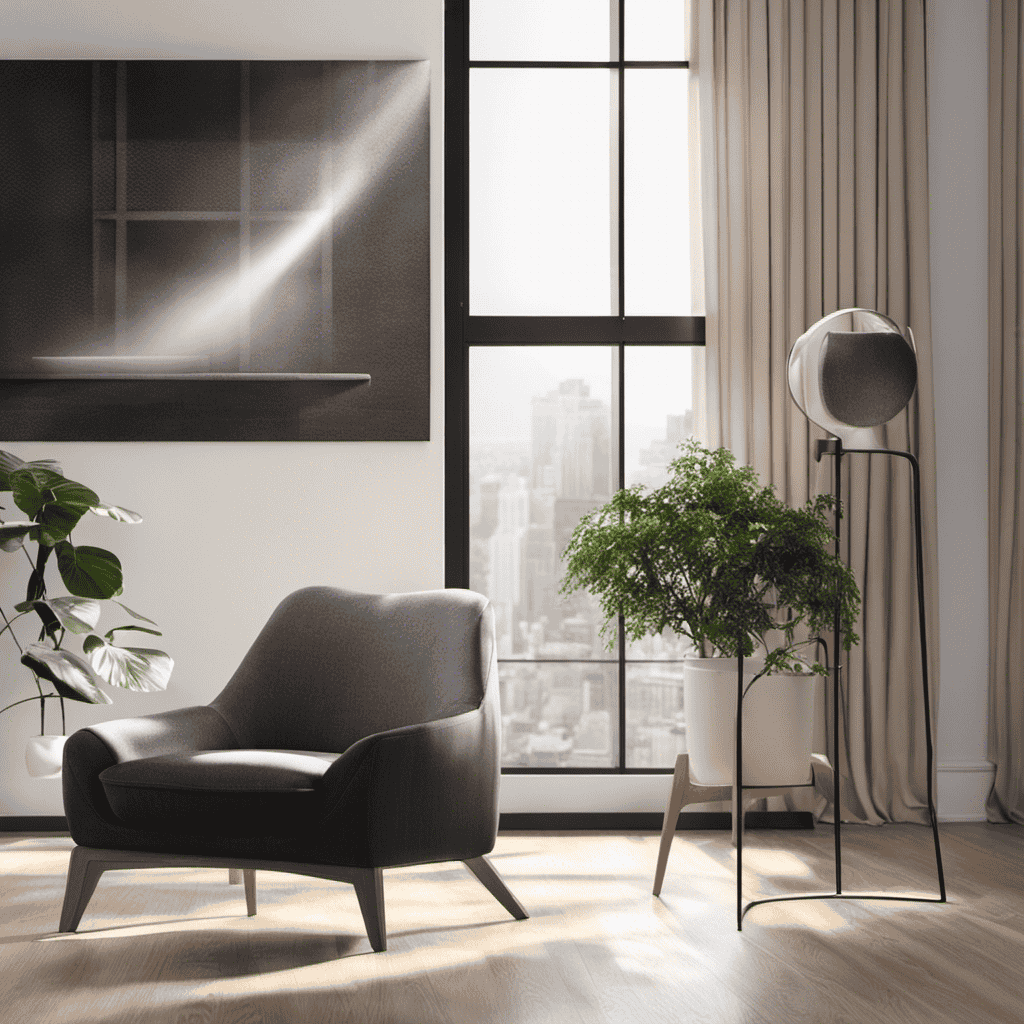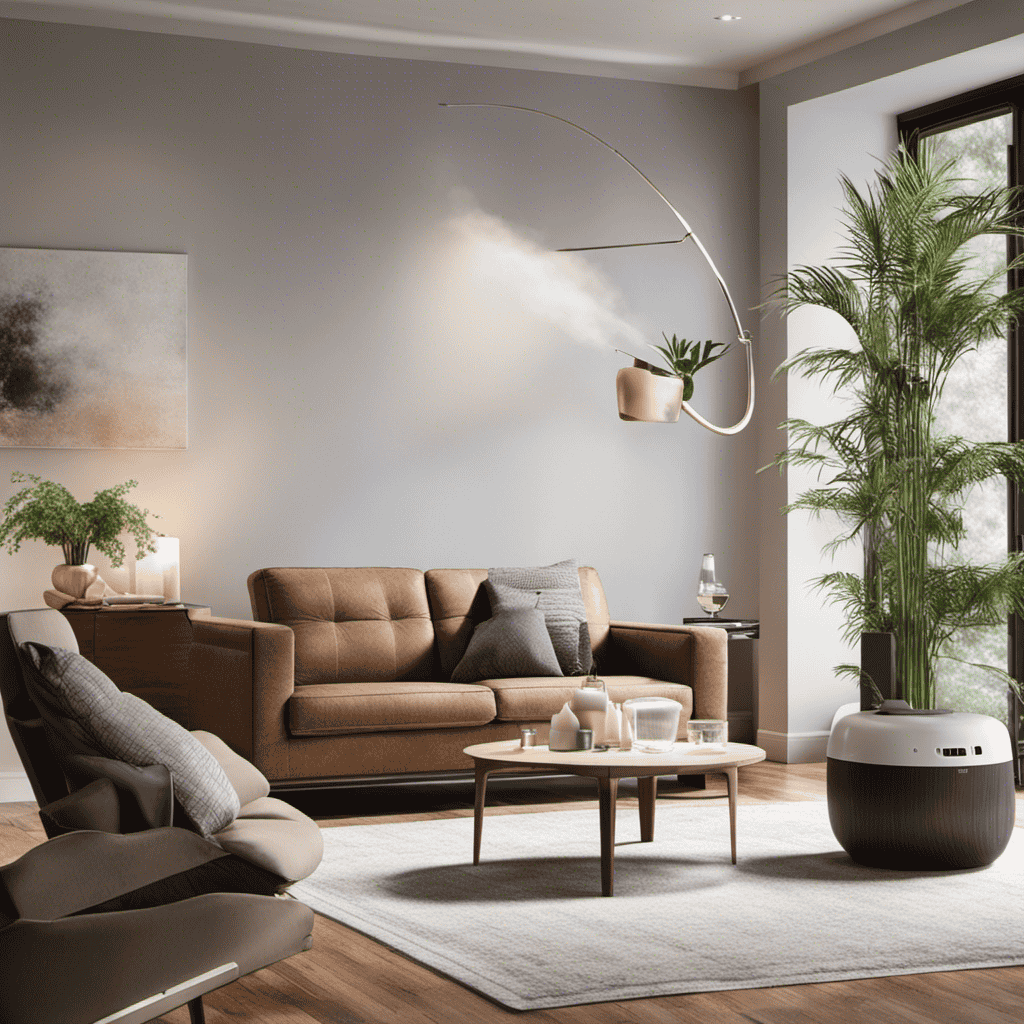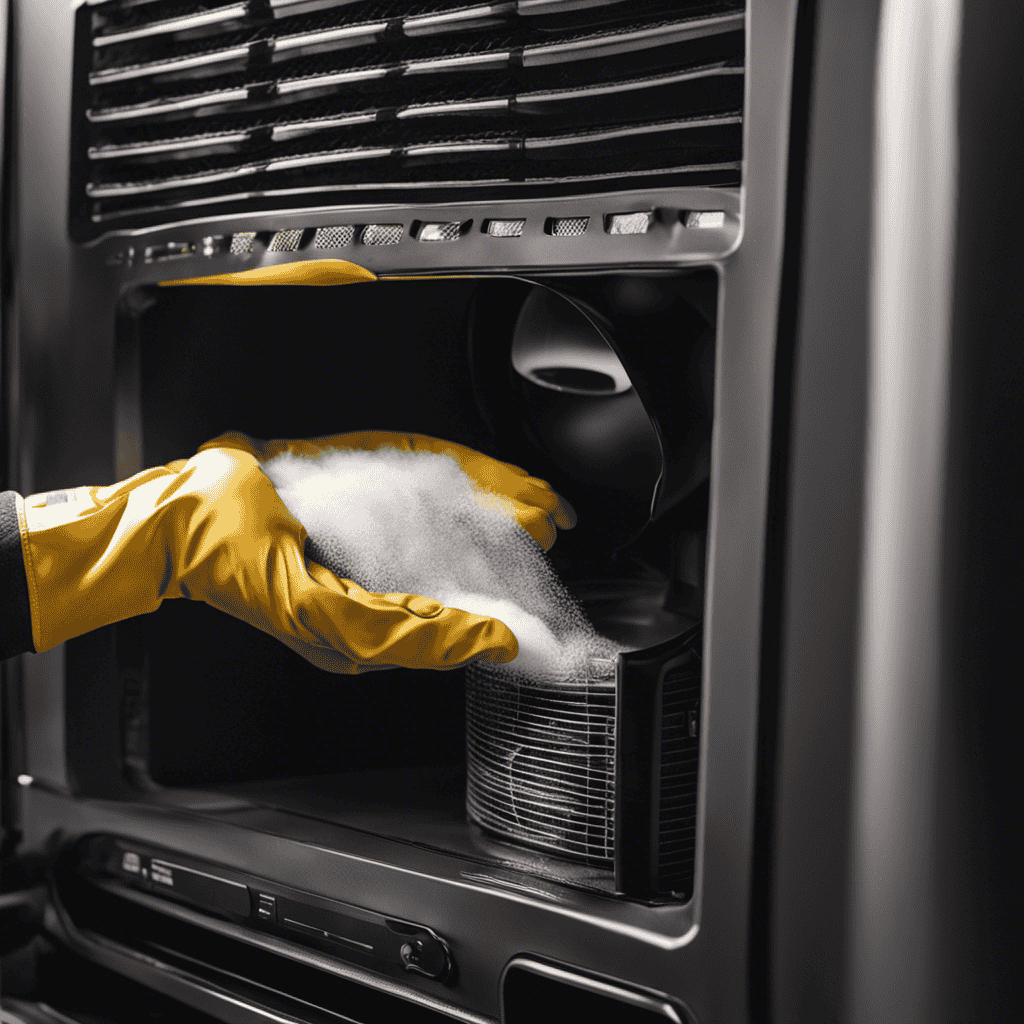When I arrive home after a busy day, I am welcomed by the crisp, invigorating smell of purified air. The reason behind this revitalizing ambiance is the charcoal air purifier bags that quietly do their job.
These small, unassuming bags are like tiny superheroes, effortlessly absorbing and eliminating unwanted odors and pollutants from the air. In this article, we will dive into the science and benefits of charcoal air purifier bags, debunk common misconceptions, and explore their effectiveness compared to other air purification methods.
Prepare to be amazed by the power of these humble bags!
Key Takeaways
- Charcoal air purifier bags absorb and trap odors and pollutants in the air through an adsorption process.
- They use activated carbon to attract and capture harmful particles, improving indoor air quality.
- Charcoal air purifier bags are highly effective in eliminating odors and absorbing pollutants, making them a natural and eco-friendly option for air purification.
- They can be used in various areas of the home, are safe around children and pets, and can be recharged by placing them in direct sunlight.
How Do Charcoal Air Purifier Bags Work
Charcoal air purifier bags work by absorbing and trapping odors and pollutants in the air. Unlike HEPA filters, which use a mechanical filtration system, charcoal air purifier bags use activated carbon to attract and capture harmful particles.
The porous structure of the bamboo charcoal allows it to effectively trap a wide range of contaminants, including allergens, chemicals, and volatile organic compounds (VOCs). The activated carbon in the bags works through a process called adsorption, where the particles adhere to the surface of the charcoal.
This helps to improve indoor air quality by reducing unpleasant smells, eliminating harmful substances, and creating a healthier living environment. Additionally, bamboo charcoal air purifier bags are eco-friendly and sustainable, as they can be reused for up to two years by simply placing them in direct sunlight to reactivate the charcoal.
Benefits of Using Charcoal Air Purifier Bags
When it comes to air purification, charcoal air purifier bags have proven to be highly effective.
Not only do they eliminate odors effectively, but they also have the ability to absorb harmful pollutants present in the air.
What makes these bags even better is that they are natural and eco-friendly, making them a great choice for those who prioritize sustainability.
Eliminates Odors Effectively
Eliminating odors effectively, these air purifier bags are a must-have for any home. Using activated charcoal as their main ingredient, these bags work by trapping and neutralizing odor-causing molecules in the air.
Here are five reasons why they are so effective:
- They absorb and eliminate pet odors, leaving your home smelling fresh and clean.
- They reduce indoor allergens by trapping and removing particles such as dust mites, pollen, and mold spores.
- They are chemical-free and safe to use around children and pets.
- They are reusable and can be reactivated by placing them in direct sunlight.
- They are versatile and can be used in various areas of your home, including closets, bathrooms, and pet areas.
With their ability to eliminate odors and reduce indoor allergens, these air purifier bags provide a healthier and more pleasant environment for you and your family. Additionally, they also absorb harmful pollutants, which we will explore in the next section.
Absorbs Harmful Pollutants
These bags are highly effective at trapping and neutralizing harmful pollutants in the air. Charcoal air purifier bags have absorbent properties that allow them to attract and capture pollutants such as formaldehyde, benzene, and ammonia.
The activated charcoal, or activated carbon, inside the bags has a porous structure that increases its surface area, allowing it to adsorb a wide range of pollutants. This adsorption process works by the charcoal attracting and holding onto the pollutants, preventing them from circulating in the air and potentially causing harm to our health.
Natural and Eco-Friendly
The use of charcoal air purifier bags is a natural and eco-friendly way to improve indoor air quality. These bags are made from eco-friendly materials and have a long-lasting effectiveness.
Here are five reasons why I believe charcoal air purifier bags are a great choice for improving indoor air quality:
- Charcoal is a natural and renewable resource, making it an environmentally friendly option.
- The porous structure of charcoal allows it to effectively absorb and trap harmful pollutants and odors.
- Unlike traditional air purifiers that require electricity to operate, charcoal air purifier bags are completely passive and do not consume any energy.
- Charcoal air purifier bags have a long-lasting effectiveness, with some brands claiming to last up to two years before needing to be replaced.
- These bags are versatile and can be placed in various areas of the home, such as closets, bathrooms, or near litter boxes, to target specific sources of odors and pollutants.
Types of Contaminants Charcoal Air Purifier Bags Can Remove
Charcoal air purifier bags are highly effective in removing various types of contaminants such as odors, allergens, and pollutants. The activated charcoal in the bags acts as a magnet for allergens, trapping them and preventing them from circulating in the air. This is particularly beneficial for individuals who suffer from allergies or asthma, as it can help reduce symptoms and improve indoor air quality.
Additionally, charcoal air purifier bags are also great for eliminating pet odors. The activated charcoal absorbs the odor molecules, neutralizing them and leaving the air fresh and clean. By effectively removing allergens and eliminating pet odors, charcoal air purifier bags provide a healthy and pleasant environment.
Now, let’s explore some tips for using these bags effectively.
Tips for Using Charcoal Air Purifier Bags Effectively
Now that we know the types of contaminants charcoal air purifier bags can remove, let’s discuss some tips for using them effectively, especially in cars.
-
Placement: Hang the charcoal air purifier bag in your car, preferably near the source of the odors or pollutants.
-
Duration: Keep the bag in your car for at least a few hours to allow it to effectively absorb the contaminants.
-
Recharging: To recharge the charcoal air purifier bag, simply place it in direct sunlight for a few hours. The heat from the sun will help release the trapped pollutants, making the bag ready for use again.
-
Frequency: Recharge the bag every few weeks or as needed, depending on the air quality in your car.
-
Replacement: After several months of use, the charcoal in the bag will become less effective. It is recommended to replace the bag with a new one to maintain optimal air purification.
How to Choose the Right Size Charcoal Air Purifier Bag
When it comes to choosing the right size charcoal air purifier bag, there are several factors to consider.
First and foremost is the bag’s efficiency in removing pollutants from the air. This is directly related to the size of the bag and the amount of activated charcoal it contains.
Secondly, one must take into account the size of the room or space that needs to be purified, as a larger room will require a larger bag to effectively clean the air.
Lastly, the duration of effectiveness is another important consideration, as some bags may need to be replaced or recharged more frequently depending on the level of pollutants in the environment.
Bag Size and Efficiency
To maximize the efficiency of your air purifier bag, you’ll want to consider the size of the bag. The effectiveness of the bag is directly related to its size and how well it can cover the area in need of purification. Here are some key factors to keep in mind when choosing the right size bag for different room sizes:
-
Room dimensions: Measure the length, width, and height of the room to determine the total volume.
-
Air exchange rate: Consider how often the air in the room needs to be purified and choose a bag size that can handle the required airflow.
-
Bag capacity: Look for bags with a higher charcoal content to ensure maximum absorption capacity.
-
Placement: Place the bag in a central location for optimal air circulation.
-
Maintenance: Remember to replace the bag regularly to maintain its effectiveness.
Considering these factors will help you choose the right size bag for your specific room size, ensuring that you get the most out of your air purifier.
As we move on to discussing room size considerations, let’s delve into more details about how different room sizes can impact the choice of air purifier bags.
Room Size Considerations
Considering the size of your room, it’s important to choose the right air purifier bag that can effectively cover the area and provide optimal purification.
When it comes to room size limitations, it’s crucial to understand that larger rooms require larger air purifier bags in order to effectively remove pollutants and maintain clean air. A small air purifier bag may not have enough capacity to handle the volume of air in a larger room, resulting in suboptimal purification.
Additionally, using multiple air purifier bags can have significant benefits. Not only can it ensure better coverage in larger rooms, but it can also provide more efficient purification by distributing the bags strategically throughout the space.
This allows for a more thorough removal of pollutants and a cleaner, healthier environment.
Duration of Effectiveness
After considering the size of the room, it is important to understand the duration of effectiveness of charcoal air purifier bags. These bags are known for their long term effectiveness in removing odors and pollutants from the air.
Charcoal air purifier bags work by trapping impurities in their porous structure. Over time, these impurities build up and reduce the bags’ ability to absorb more pollutants. To maintain their effectiveness, the bags need to be recharged periodically.
The recharging process involves exposing the bags to sunlight for a few hours. The heat and UV rays help to release the trapped impurities, allowing the bags to regain their original absorption capacity.
To ensure the longevity of charcoal air purifier bags, it is recommended to follow these recharging steps:
- Place the bags in direct sunlight.
- Leave them exposed for at least 2-3 hours.
- Rotate the bags occasionally to ensure even recharging.
- Repeat this process every 1-2 months, or as instructed by the manufacturer.
- Replace the bags when they no longer effectively remove odors or pollutants.
Common Misconceptions About Charcoal Air Purifier Bags
You might think charcoal air purifier bags only remove odors, but they actually have a range of benefits beyond that. One common misconception is that these bags are only effective in small spaces. However, studies have shown that charcoal bags can effectively purify the air in larger rooms as well.
Another misconception is that they are only useful for eliminating smells caused by pets or cooking. In reality, charcoal bags can also remove harmful pollutants such as formaldehyde, benzene, and ammonia. Additionally, they are a natural and eco-friendly option for air purification, as they do not release any chemicals into the air.
However, it is important to note that charcoal bags have some drawbacks. They have a limited lifespan and need to be replaced regularly to maintain their effectiveness. Furthermore, they may not be as effective in highly polluted areas.
Despite these drawbacks, charcoal air purifier bags offer several benefits and can be a valuable addition to your air purification routine.
Now, let’s compare charcoal air purifier bags to other air purification methods.
Comparing Charcoal Air Purifier Bags to Other Air Purification Methods
Now that we’ve cleared up some misconceptions about charcoal air purifier bags, let’s compare them to other air purification methods.
One commonly used method is HEPA filters, which are known for their ability to capture tiny particles. Here’s how charcoal air purifier bags stack up:
- Charcoal air purifier bags vs. HEPA filters:
- Charcoal air purifier bags use activated charcoal to absorb odors and pollutants, while HEPA filters physically trap particles.
- Charcoal bags are typically more affordable than HEPA filters.
- HEPA filters require regular replacement, while charcoal bags only need to be rejuvenated by placing them in the sun.
- Charcoal bags are portable and can be placed anywhere, while HEPA filters are usually installed in specific devices.
- HEPA filters may be more effective in capturing smaller particles, but charcoal bags excel in odor absorption, including pet dander.
Overall, charcoal air purifier bags offer a cost-effective and convenient option for improving indoor air quality, especially when it comes to eliminating pet dander and odors.
Frequently Asked Questions About Charcoal Air Purifier Bags
If you’re wondering about the lifespan of charcoal air purifier bags, they typically last for about two years before needing to be replaced.
Charcoal air purifier bags are an effective and natural solution for improving indoor air quality, especially for those with allergies. The porous structure of activated charcoal helps to absorb and trap harmful particles, allergens, and odors, making the air cleaner and fresher.
Traditional air fresheners, on the other hand, often contain chemicals that can be harmful to our health and the environment. Charcoal air purifier bags do not emit any chemicals or fragrances, making them a safer alternative.
Additionally, charcoal air purifier bags are reusable and eco-friendly, as they can be rejuvenated by placing them in direct sunlight every few months.
Overall, charcoal air purifier bags provide numerous benefits for allergy sufferers and are a healthier and more sustainable option compared to traditional air fresheners.
Frequently Asked Questions
Are Charcoal Air Purifier Bags Safe to Use Around Pets and Children?
Yes, charcoal air purifier bags are safe to use around pets and children. They are effective at improving indoor air quality and are a great alternative to other air purifiers.
Can Charcoal Air Purifier Bags Remove Cigarette Smoke Odor?
When it comes to getting rid of cigarette smoke odor, charcoal air purifier bags work wonders. They’re like tiny superheroes, swooping in and eliminating those pesky smells, unlike traditional air purifiers. Plus, they tackle cooking odors too!
How Long Do Charcoal Air Purifier Bags Last Before Needing to Be Replaced?
Charcoal air purifier bags typically last for about 1-2 years before needing to be replaced. Signs that they need to be replaced include a decrease in odor-absorbing effectiveness and a noticeable increase in unpleasant odors.
Can Charcoal Air Purifier Bags Remove Allergens Like Pollen and Pet Dander?
Charcoal air purifier bags are effective in reducing indoor air pollution by removing allergens like pollen and pet dander. This is beneficial for people with allergies as it helps improve air quality and reduces symptoms.
Do Charcoal Air Purifier Bags Eliminate Mold and Mildew Odors?
Yes, charcoal air purifier bags work on musty basement smells and can be used in cars. They eliminate mold and mildew odors by absorbing and trapping the particles responsible for the unpleasant smells.
Conclusion
In conclusion, charcoal air purifier bags are truly miraculous in their ability to clean the air we breathe. These small bags are like superheroes, swooping in to rid our homes of harmful contaminants.
With their powerful activated charcoal, they absorb and trap pollutants, leaving behind only fresh, clean air. The benefits are astonishing – from reducing unpleasant odors to removing allergens and toxins.
Forget about other air purification methods, because these bags are the ultimate solution. So go ahead, embrace the power of charcoal and let these bags work their magic in your home.










